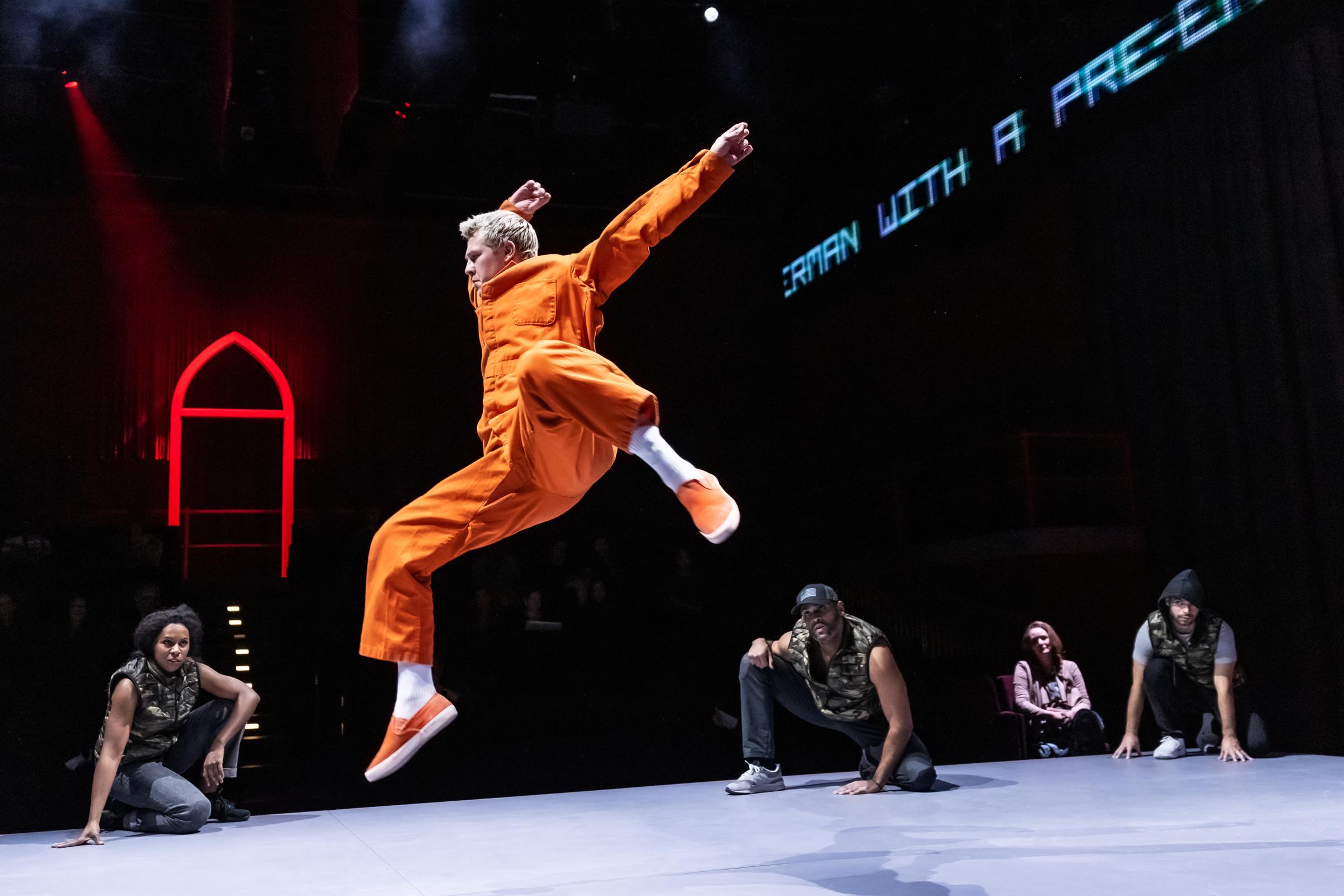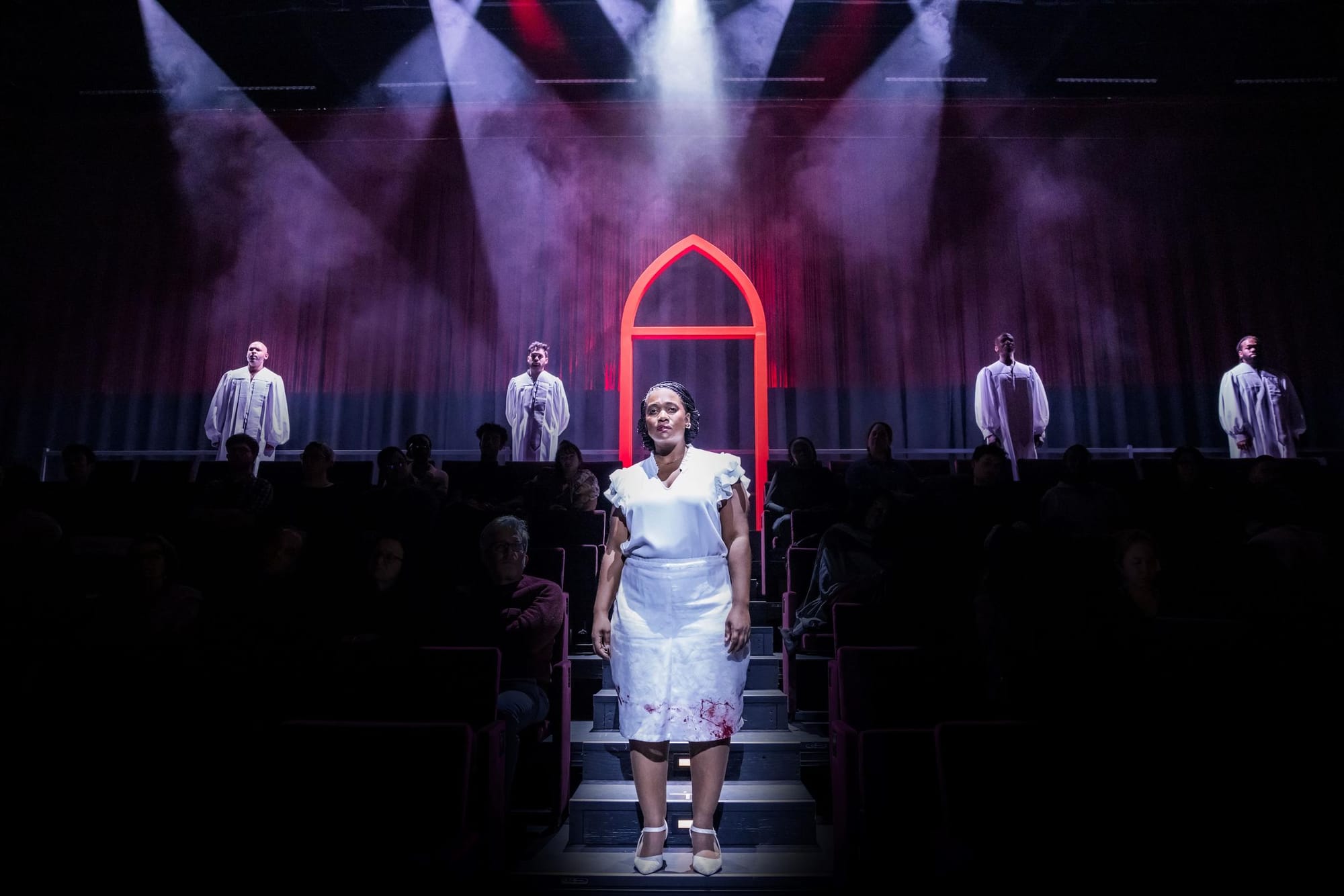Watch Night
The Perelman Performing Arts Center (PAC NYC)
251 Fulton Street, New York, NY
Through Nov. 18, 2023
“Start with the white savior teacher?
Or maybe the slick Black preacher?”
Midway through Watch Night, Josh, a journalist and leading character in the show, sits at his laptop pondering how exactly to open and frame his next story. He’s writing about a recent mass shooting at the Red Black and Gold African Methodist Episcopal Church in Charleston, South Carolina. Given the gravity of the subject matter, and the multitude of accounts and perspectives at play in his reporting, choosing the right angle is challenging. How do you fully capture the depth and complexity of responses to unimaginable violence, do justice to the communities one simultaneously writes about and is part of, and neatly wrap those things up into a piece worth reading?
At that moment, the answers weren’t immediately obvious to Josh. Nor are they to me now, as I endeavor to write this review while asking myself a similar set of questions.
Watch Night -- a world-premiere co-conceived by director and choreographer Bill T. Jones and librettist Marc Bamuthi Joseph, composed by Tamar-kali, with dramaturgy by Lauren Whitehead, commissioned for the inaugural season of lower Manhattan’s newly opened Perelman Performing Arts Center — is ambitious in both scope and form. The piece “code-surfs” among opera, dance, and spoken word poetry as the limits of congregants’ faith and forgiveness are tested in the wake of mass shootings perpetrated at two houses of worship. The piece was catalyzed by, though not a direct dramatization of, the 2015 Charleston Church Shooting and 2018 Pittsburgh Synagogue Shooting.
Leading the narrative charge are Josh (played by Brandon Michael Nase), the aforementioned reporter covering these heinous acts of violence; “The Wolf” (played by Kevin Csolak), the moniker given to the perpetrator of the initial shooting, who ultimately becomes the main subject of Josh’s reporting; and Shayla (played by Danyel Fulton), an AME congregant and corrections officer working on death row, where The Wolf has been sentenced.
Primarily through Josh and Shayla’s eyes, we also learn the stories of and ideological conflicts among Winters (played by Sola Fadiran); AME’s pastor, Rabine (played by Brian Golub); the rabbi of nearby Spring Hope synagogue; Ms. Laura (played by Josette Elaine Newsam), the sole survivor of the initial AME shooting; and Ms. Summers (played by Jill Paice), The Wolf’s 10th grade English teacher.
Each character in the latter group rises above and beyond the status of mere trope, in part due to some stellar performances by Fadiran, Golub, Newsam, and Paice. But the abundance of stories being told in the piece, often in ways meant to highlight contrasting views, means that I didn’t get as much time to experience each individual’s depth and complexity as I would’ve liked.
For example, a scene between Winters and Rabine quickly turns into a captivating confrontation between the Christian concept of forgiveness and the Jewish concept of teshuvah. But these thought-provoking ideological conflicts verge on swallowing up the individuals who express them.
The above is but one example of what makes viewing (and reviewing) Watch Night challenging: many of the features that make this piece and production fascinating, rich, and unique are double-edged, bringing with them a set of dissonant consequences.
Other examples that come to mind: Watch Night’s one-of-a-kind hybridization of opera, dance, and spoken word poetry is such a compelling and powerful vehicle for storytelling, and all elegantly composed by Tamar-kali, but the regular surfing between these modes can, at times, be overstimulating. Jones’ staging and choreography take full advantage of the space in an alley-style seating configuration (one of over 60 configurations creative teams can choose in the modular Perelman PAC theaters). But with action sometimes occurring in front, behind, to the side of, and above theatergoers, trying to see everything Jones’ brilliant work has to offer may require a few more head turns than is reasonable, depending on one’s sightline.
In terms of design, there’s a similar phenomenon. The supertitles of the piece are selectively active, often used to emphasize specific words or phrases from each character and displayed on large, long projection surfaces that run above the left and right edges of the theater, perpendicular to the alley stage. Each character’s supertitles have their own specific personality in terms of font, color, text speed, orientation, and background, thanks to innovative projections design by Lucy MacKinnon. But, the fact that the immaculately designed supertitles are only active some of the time compromises their ability to be used the way an operagoer would traditionally engage with them- to understand every word that is sung through.

In many cases, I’m not sure how much these consequences can be mitigated without simultaneously weakening the aspects of the show that make Watch Night special. That puts me in a tough, yet interesting position as a viewer, and reviewer.
Perhaps that’s by design.
In Watch Night’s program, there’s a “notes to myself” section from Jones, which outlines a series of dos and don’ts to keep in mind in the creation of the piece. Near the top of his list: “DO NOT Create an event too easily digested in its desire to succeed by standards not of my making.” In that respect at the very least, Watch Night is a triumph.
Still Playing: WATCH NIGHT runs until Nov. 18 at the Perelman PAC. Tickets are available here.
Up Next For Me: I’ll be seeing Roundabout Theater Company’s production of Covenant.






